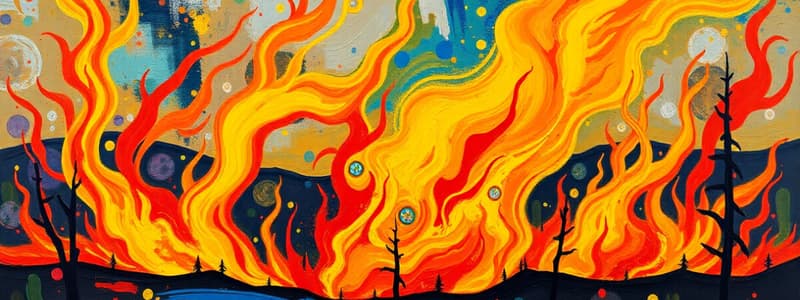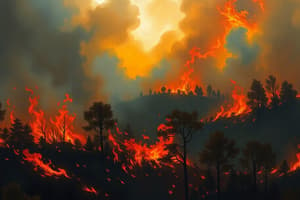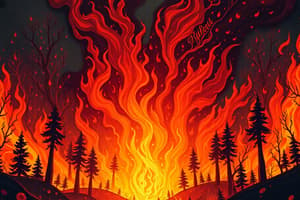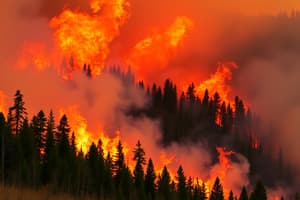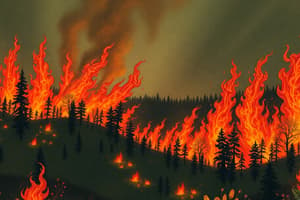Podcast
Questions and Answers
What percentage increase in wildfires was recorded in 2023 compared to 2022?
What percentage increase in wildfires was recorded in 2023 compared to 2022?
- 150 percent
- 170 percent (correct)
- 70 percent
- 200 percent
What causes zombie fires to resurface after the snow melts?
What causes zombie fires to resurface after the snow melts?
- Heavy winds that spread the flames
- Increased rainfall in spring
- Dry conditions under the snow (correct)
- Natural gas leaks underground
How long can zombie fires remain active underground?
How long can zombie fires remain active underground?
- Less than two months
- Weeks, months, or even years (correct)
- Only until the first snowfall
- Days or weeks only
Which regions besides Canada are known to experience zombie fires?
Which regions besides Canada are known to experience zombie fires?
What factor contributes to the challenge of detecting zombie fires?
What factor contributes to the challenge of detecting zombie fires?
What role does organic matter play in the survival of zombie fires?
What role does organic matter play in the survival of zombie fires?
Why have there been more zombie fires in British Columbia and Alberta in recent years?
Why have there been more zombie fires in British Columbia and Alberta in recent years?
What is another term used for zombie fires?
What is another term used for zombie fires?
What is a primary implication of failing to extinguish holdover fires?
What is a primary implication of failing to extinguish holdover fires?
What method is primarily used to extinguish holdover fires?
What method is primarily used to extinguish holdover fires?
Under what conditions might holdover fires be less likely to emerge?
Under what conditions might holdover fires be less likely to emerge?
Why are cold trailing efforts often considered overlooked in wildfire management?
Why are cold trailing efforts often considered overlooked in wildfire management?
Which environmental factors contribute to the resurgence of holdover fires?
Which environmental factors contribute to the resurgence of holdover fires?
What has been the primary impact of recent rainfall on wildfires near Fort McMurray?
What has been the primary impact of recent rainfall on wildfires near Fort McMurray?
What precautionary measure is being advised for residents near Fort McMurray?
What precautionary measure is being advised for residents near Fort McMurray?
How are firefighters managing the wildfires near Fort Nelson, BC?
How are firefighters managing the wildfires near Fort Nelson, BC?
What response has been observed from Fort Nelson residents following the heavy rainfall?
What response has been observed from Fort Nelson residents following the heavy rainfall?
What is the current status of the wildfires near Cranberry Portage, Manitoba?
What is the current status of the wildfires near Cranberry Portage, Manitoba?
Flashcards
Zombie Fires
Zombie Fires
Wildfires that appear to come back to life after being dormant under the snow.
How do zombie fires burn?
How do zombie fires burn?
The fires burn within organic matter like peat, smoldering underground for extended periods.
What fuels zombie fires?
What fuels zombie fires?
Zombie fires are fueled by dry organic matter like peat, allowing them to smolder for weeks, months, or even years.
Why are zombie fires hard to detect?
Why are zombie fires hard to detect?
Signup and view all the flashcards
How are zombie fires 'flameless'?
How are zombie fires 'flameless'?
Signup and view all the flashcards
Why are there more zombie fires this year?
Why are there more zombie fires this year?
Signup and view all the flashcards
Where do zombie fires occur?
Where do zombie fires occur?
Signup and view all the flashcards
Why are zombie fires a concern?
Why are zombie fires a concern?
Signup and view all the flashcards
Holdover Fire
Holdover Fire
Signup and view all the flashcards
Cold Trailing
Cold Trailing
Signup and view all the flashcards
Resurgence of Holdover Fires
Resurgence of Holdover Fires
Signup and view all the flashcards
Extinguishing Holdover Fires
Extinguishing Holdover Fires
Signup and view all the flashcards
Importance of Cold Trailing
Importance of Cold Trailing
Signup and view all the flashcards
What's the impact of rain on wildfires?
What's the impact of rain on wildfires?
Signup and view all the flashcards
Why are authorities cautious despite rain?
Why are authorities cautious despite rain?
Signup and view all the flashcards
What are holdover fires?
What are holdover fires?
Signup and view all the flashcards
What is 'cold trailing'?
What is 'cold trailing'?
Signup and view all the flashcards
What can cause holdover fires to reignite?
What can cause holdover fires to reignite?
Signup and view all the flashcards
Study Notes
2023 Canadian Wildfires - Zombie Fires
- 2023 wildfire season was the worst on record, with over 6,500 blazes scorching over 48 million acres, a 170% increase from 2022.
- Fires calmed by snowfall, but many were not fully extinguished.
- "Zombie fires" - fires smoldering under snow, reigniting in warmer weather.
- Holdover or overwintering fires burn underground for weeks, months, or even years, sustained by organic matter (e.g., peat).
- Igniting factors include lightning strikes and controlled burns.
- 2023 saw a significant surge in zombie fires; estimates indicate 93 in BC and over 55 in Alberta. Normally, there are fewer than 15 annually.
- Difficult to detect due to remote locations, mainly flameless nature, and frozen ground hindering monitoring.
- Low precipitation and warmer winters over the past three years allowed fires to persist.
- Not unique to Canada; Alaska, Northern Europe, and Siberia also experience similar phenomenon.
- Similar characteristics from cool coniferous forests with thick layers of flammable vegetation.
- Fires can smolder underground throughout the winter, moving slowly.
- Fires can move 6 inches in a month or 100 meters after wild fire season has ended.
- Firefighters look for smoldering embers in the ground after a wildfire to ensure no hotspots remain.
- Even a single ember can reignite a forest fire.
- Holdover fires persist underground.
- Holdover fires are difficult to detect, especially when there is snow.
- Firefighters rely on public calls to report potential holdover fires.
- Holdover fires can be a significant concern as they can reemerge in warmer weather.
- Drought conditions and warm temperatures can contribute to the resurgence of holdover fires.
- The contribution of individual holdover fires to the total area burned is generally small, but can be substantial in years with severe fire conditions.
- Soil must be exposed to air and then flooded with water to extinguish holdover fires.
- Failure to extinguish holdover fires could lead to new fires in the spring.
- Cold trailing is a vital, but often overlooked, aspect of wildfire prevention and management.
- This work can help prevent large fires from starting again in the spring and protect communities from devastating wildfires.
- Wildfire is still a threat near Fort McMurray, despite much-needed rain.
- Families are seeking refuge and hoping for a quicker return home.
- Rain significantly helps control the fire, providing relief for residents.
- Firefighters are working tirelessly to contain the blaze and protect communities.
- Residents are advised to stay evacuated until Tuesday, potentially longer than expected.
- Authorities are cautious due to the risk of a second evacuation.
- Colder weather and rainfall provide much-needed respite for Fort Nelson, BC.
- Fort Nelson residents express immense relief after heavy rainfall.
- Two wildfires near the town are being contained by firefighters and rain.
- The fire near Cranberry Portage, Manitoba is being held back and rain is expected in the forecast.
Studying That Suits You
Use AI to generate personalized quizzes and flashcards to suit your learning preferences.
Description
Explore the alarming rise of zombie fires during the 2023 wildfire season in Canada. This quiz covers the impact of these smoldering fires, their causes, and their persistence under snow. Learn about the effects of climate conditions and how this phenomenon is not limited to Canada alone.
